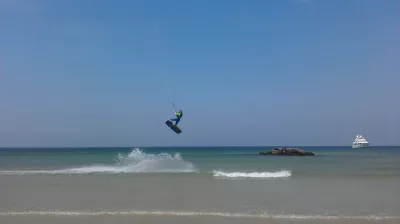Learning to Kitesurf in Europe's Kitesurfing Mecca
What is kitesurfing?
We should start out by explaining what kitesurfing is as this alone often causes some confusion!
Kitesurfing or lancing kitesurfing (from the English kite - a kite and board - a board, boarding - riding a board) or kiting is a sport, the basis of which is movement under the action of a traction force developed by a kite held and controlled by an athlete. Due to innovations in the design of kites, improved management systems and the development of kitesurfing schools, the safety of the sport has significantly increased.
Lancing kitesurfing is fraught with considerable difficulties and dangers for both the rider and other vacationers on the water. They can be avoided if you start training under the guidance of an experienced instructor. It should be borne in mind that kitesurfing is an extreme sport in which you can get injured even with full observance of safety rules.
Kitesurfing consists of a board, a lot like a wakeboard, which is attached to your feet. You wear a harness connected to a kite via 20 metre long lines which you control using a kitebar. With the kite in the air, you can use the power of the wind to pull you across the water. If this sounds exhilarating - it is!
A common question that is asked by novices interested in getting into the sport is “Do I need to be strong?”. The answer is no. You only need a basic level of fitness and contrary to popular belief, you do not need good arm strength as you are connected to the kite from your waist via a harness. You only use your arms to maneuver the kite which requires very little strength.
Where is Tarifa?
Kitesurfing requires a combination of suitable beaches and reliable winds which is what has led to Tarifa becoming Europe’s mecca for Kitesurfing. Based on the Southern tip of Andalusia in Spain, and just opposite the Morrocco, Tarifa offers ideal conditions for learning to kitesurf.
Tarifa has a beautiful Old Town adorned with narrow alleyways and squares which offer the perfect spot for al fresco tapas and exploring. Late at night, the town comes alive with bars selling beer and cocktails. There are also some excellent steak restaurants with Vaca Loco topping the list as a favourite amongst kitesurfers for their juicy flame grilled steaks, served on a rustic wooden platter with a generous portion of fries.
Sunset is the perfect time to head down to one of the beach bars near the Old Town to watch the sunset with a beer in hand. You will have a perfect view of the sun setting over the ocean.
Importantly the town is also awash with kitesurfing schools where you can get information on kitesurfing lessons and rent equipment. Our favourite is KTS Tarifa which is well established and offers professional lessons in a variety of languages.
Most of the kitesurfing action takes place a few miles west of the town along the vast expanse of beach called Playa de Los Lances. Further up you have some more spots such as Valdevaqueros and there are plenty of chiringuitos where you can grab a drink or some lunch, or just chillout and sunbathe.
The best option is to have a rental car but most of the kite schools will be able to transport you to and from the beaches. The ideal beach depends on wind conditions so this is also a good option.
How long does it take to learn?
Learning to kitesurf is generally broken into 4 stages. You will need a qualified instructor and can either have individual or group lessons. Kitesurfing schools will offer lessons which include rental of equipment.
Firstly you will learn about the equipment. The essentials are a kite, bar and lines, harness and a board. The size of kite you use will depend on your weight and the wind strength. In cold weather you will also need a wetsuit. Stage 1 involves just the kite and the harness where you will learn how to control the kite including how to launch and land it.
Once you have basic control of the kite which normally takes half a day, you can move to stage 2 which involves entering the water with the kite. The aim here is to learn the feel of the kite as it drags you through the water. You will begin to understand the power or the kite and how to direct it so it pulls you in the desired direction. Get ready for a face full of water!
Once you have mastered stage 2 which can take from half a day to a few days, you can move to stage 3 which involves taking the board into the water with you. You will practice keeping the kite in the neutral position (directly above you) whilst attaching the board to your feet using the footstraps, and then using the control bar to direct the kite in the direction you wish to travel. Using a combination of kite control and body position, your aim is to stand up and have the kite pull you across the water. This stage can take from half a day to a number of days!
Once you are able to practice stage 3 safely you can move from ‘instruction’ to ‘supervision’. It’s now all about practice. Many schools will offer ‘supervision’ whereby you can rent the equipment from them and they will keep an eye on you whilst you take your time learning to get up and riding. As the wind will be blowing you ‘downwind’, you will need to exit the water and walk back up the beach before re-entering ‘upwind’ for your next practice run.
After some practice you will be up and riding and feeling the adrenaline that makes this sport so addictive! As you continue to practice, you may notice that you are struggling to arrive back to the beach at the same spot you left off. This is where ‘staying upwind’ becomes your objective and is the 4th and final part of kitesurfing that will make you an ‘independent kitesurfer’. To accomplish this you need to practice the balance of having the kite in the right position and using the edge of your board to make sure that you are travelling across the wind rather than letting it pull you downwind.
Accomodation in Tarifa
There's plenty of accommodation choice in Tarifa and Airbnb is a good place to check. If you prefer a low cost hostel there are a number of them including La Cocotera in the Old Town which boasts a roof terrace with views of Morroco’s Atlas Mountains and is popular for it’s co-working space.
Book your stay in La Cocotera Boutique Hostel & Coworking on Booking.comSo there we have it. It’s no wonder that kitesurfing is one of the world’s fastest growing watersports. We recommend a 3 day course to get started and before long you will be an independent kitesurfer. From here you can start learning some of the basic tricks like jumps and back rolls. A world of adrenalin awaits!

Jonathan Hedger has been kitesurfing since 2005 and is owner of Kitesurfshack, a website for kitesurfing t-shirts and gifts.
Frequently Asked Questions
- What makes Europe's kitesurfing mecca ideal for learning the sport, and what can beginners expect from the training experience there?
- Europe's kitesurfing mecca offers ideal conditions like consistent winds and wide beaches, making it perfect for beginners. Training experiences include professional instruction, a focus on safety, and the opportunity to learn alongside a diverse community of kitesurfers.

